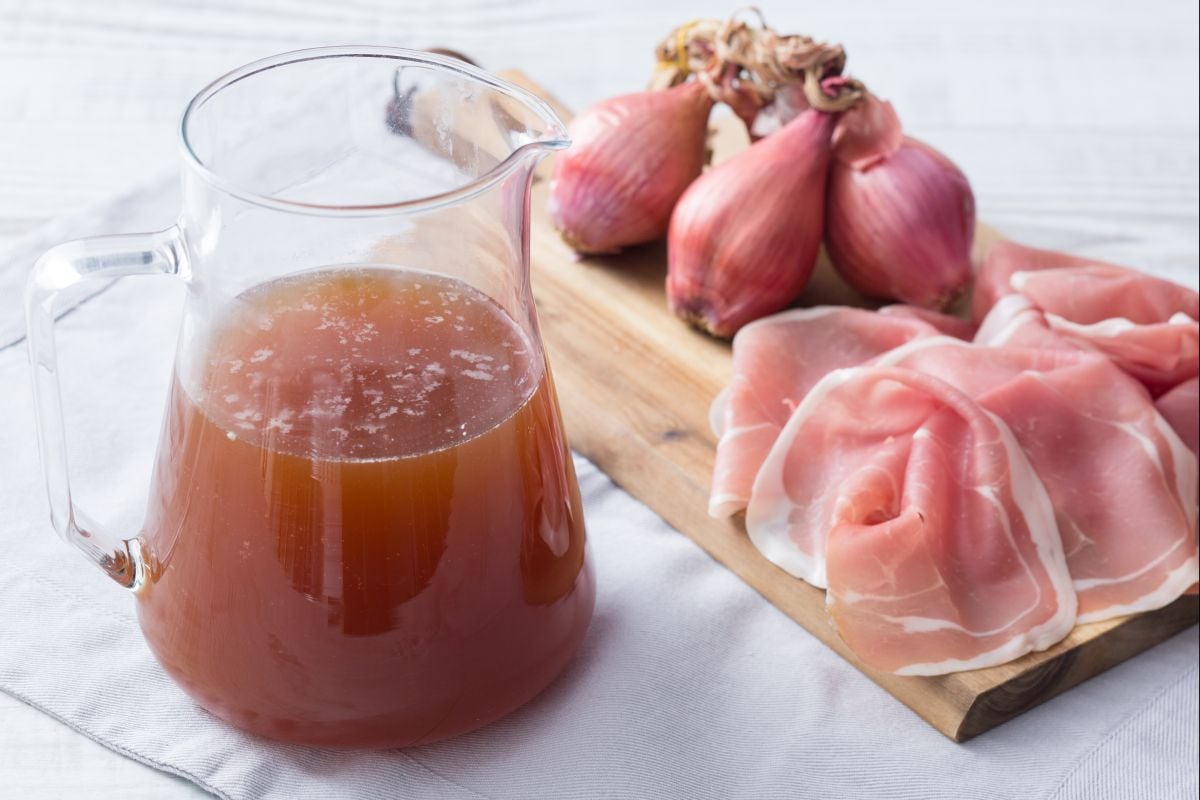Ham broth

- Gluten Free
- Lactose Free
- Energy Kcal 139
- Carbohydrates g 0.4
- of which sugars g 0.4
- Protein g 11.7
- Fats g 10
- of which saturated fat g 3.03
- Fiber g 0.2
- Cholesterol mg 30
- Sodium mg 1120
- Difficulty: Average
- Prep time: 20 min
- Cook time: 60 min
- Serving: 4
- Cost: Average
- Note plus 2 hours in the freezer
PRESENTATION
So, ham broth—it's kind of a big deal in northern Italy, especially when it's cold and everyone's huddling up for those cozy winter meals. You know, regions like Emilia-Romagna and Lombardy? They’re all about it. Ham broth is like the star of both laid-back family dinners and fancier events. There's just something about a good brodo—it makes everything feel so, so warm and inviting. And you know what? People go for homemade ham broth during the holidays, adding prosciutto crudo for that special zing. Whether it's tortellini in brodo or something unexpected like merluzzo sfogliato (flaked cod), it just makes meals pop. Chef Andrea Berton, up north, he's famous for this kind of stuff, and for real, it’s easy to see why. A bowl of tender pasta in ham broth just brings smiles all around, whether it’s a holiday or just a chill Sunday lunch.
And look, some folks like to mix it up—using a ham bone or some smoked ham. It gives the ham stock this rich and savory flavor that’s seriously good. For those who love heartier food, capon broth is another classic in the region, but ham bone broth? It’s deep and a bit sweet, standing out when you want something special. Regional traditions are fun like that—a cook in Parma might toss in different aromatics than someone in Bergamo. People rave about the golden color of a top-notch ham broth recipe. It can make the simplest pasta or rice dish unforgettable. With so many ways to use ham broth—from soups to risottos to that secret sauce boost—it’s no wonder this stuff has such a beloved spot in Italian kitchens. Here's the thing: a good ham stock recipe really brings out those moist and comforting flavors that make winter meals in northern Italy unforgettable. Whether it’s a festive gathering or just a cozy night in, ham broth makes every meal feel way, way more special. Cannot go wrong.
You might also like:
- INGREDIENTS
- Prosciutto crudo 1.3 lbs (600 g) - 15 months of aging
- Shallot 7 oz (200 g)
- Extra virgin olive oil 1 ½ tbsp (20 g)
- Water 4 ½ cups (1.1 l) - cold
How to prepare Ham broth

Start by making the ham broth. Take the slightly thick slices of ham and stack them on top of each other. Then, using a sharp knife, cut them into julienne strips 1. Continue like this until you finish the ham. You should achieve a regular cut that allows for even browning, enhancing the broth's flavor. Set the ham aside and focus on the shallots. First, peel them (2-3).

Then cut them in half lengthwise 4 and into thin, even slices 5. At this point, heat a saucepan and add a splash of oil to provide some richness 6.

When the oil is hot, add the ham 7 and let it brown, stirring often 8, until it becomes crispy when tasted. This step is crucial as it extracts the ham's flavor and saltiness, so no additional salt is needed for the broth. Once the ham is well roasted, add the shallots 9.

Keep stirring and let them braise together. Once you achieve an even browning 10, you can add the cold water 11. Increase the heat and initially opt for a high flame boil 12 to release impurities. Then lower the heat and continue cooking for another 45 minutes. This slow boil helps achieve a clearer and more transparent broth.

After the necessary time 13, place a thinly woven paper over a sieve. Alternatively, you can use a food-grade gauze. Using a ladle, scoop out only the liquid, setting aside the ham and shallots for later, and pour it into the sieve 14 to filter. Once all the broth is obtained 15, store it in the fridge for the next 24 hours, and in the meantime, prepare the ham powder.

After 24 hours, retrieve the broth. You'll notice the dark liquid remains at the bottom while the fat floats on top 16. Use a ladle to remove the fat 17 until you obtain a clear, fully defatted broth 18.
